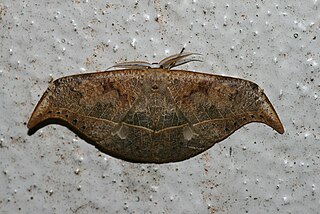
Caradrina clavipalpis, the pale mottled willow, is a moth of the family Noctuidae. The species was first described by Giovanni Antonio Scopoli in his 1763 Entomologia Carniolica. It is found in the Palearctic realm. It is an introduced species in North America, where it was first reported from Queens in New York City in 1993. In 2009 it was found in Rochester, New York, so it appears to be established and spreading.
Poliosia is a genus of moths in the family Erebidae.

Hulodes caranea is a species of moth of the family Erebidae first described by Pieter Cramer in 1780. It is found from India, Sri Lanka, Myanmar, Java, Hong Kong to Queensland and New Guinea, it is also found on the Marianas and Carolines.

Mythimna decisissima is a moth of the family Noctuidae first described by Francis Walker in 1856. It is found from India across south-east Asia including Hong Kong, Japan, Taiwan and Australia in Queensland and New South Wales. It is also present in South Africa.

Mythimna irrorata is a moth of the family Noctuidae first described by Frederic Moore in 1881. It is found in the north-western parts of the Himalayas and Sri Lanka.

Pterocyclophora pictimargo is a moth of the family Noctuidae. It was first described by George Hampson in 1893 and it is found in Sri Lanka.
Digama hearseyana is a moth of the family Erebidae described by Frederic Moore in 1859. It is found in India, Nepal, Sri Lanka and Pakistan. Two subspecies are recognized.

Canucha specularis is a moth of the family Drepanidae described by Frederic Moore in 1879. It is found in Hong Kong, India, southern China, Sundaland and Sulawesi.
Acrapex hamulifera is a moth of the family Noctuidae first described by George Hampson in 1893. It is endemic to Sri Lanka.
Anoratha paritalis is a moth of the family Erebidae. It was first described by Francis Walker in 1859 and is found in Sri Lanka.

Teulisna tumida is a species of moth of the family Erebidae first described by Francis Walker in 1862. It is found in Borneo, Sumatra, China, India, Sri Lanka, Thailand and Taiwan.
Schrankia croceipicta is a species of moth of the family Erebidae. It was first described by George Hampson in 1893. It is found in Sri Lanka and the Seychelles.
Gymnoscelis roseifascia is a moth in the family Geometridae. It is endemic to Sri Lanka.

Hypomecis separata is a species of moth of the family Geometridae. It was first described by Francis Walker in 1863. It is found in Sri Lanka, India, Java and Borneo.
Eugoa trifasciella is a moth of the family Erebidae. It is found in Sri Lanka.
Eoophyla nigerialis is a moth in the family Crambidae first described by George Hampson in 1906. It is found in Cameroon and Nigeria.
Polygrammodes sanguifrons is a moth in the family Crambidae. It was described by George Hampson in 1913. It is found in Peru.
Syllepte retractalis is a moth in the family Crambidae. It was described by George Hampson in 1912. It is found in the Democratic Republic of the Congo, Ghana and Ivory Coast.
Paralbara perhamata is a moth in the family Drepanidae. It was described by George Hampson in 1892. It is found in Northeast India including Sikkim and in Borneo.
Paragnorima fuscescens is a moth in the family Drepanidae. It was described by George Hampson in 1893. It is found in India, Nepal, China, Vietnam, Thailand and Myanmar.






